 W
WCtenodactylus is a genus of rodent in the family Ctenodactylidae.
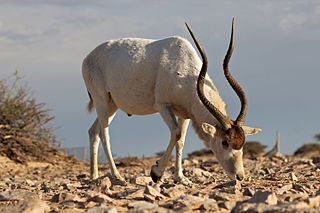 W
WThe addax, also known as the white antelope and the screwhorn antelope, is an antelope of the genus Addax, that lives in the Sahara Desert. It was first described scientifically by Henri de Blainville in 1816. As suggested by its alternative name, this pale antelope has long, twisted horns - typically 55 to 80 cm in females and 70 to 85 cm in males. Males stand from 105 to 115 cm at the shoulder, with females at 95 to 110 cm. They are sexually dimorphic, as the females are smaller than the males. The colour of the coat depends on the season - in the winter, it is greyish-brown with white hindquarters and legs, and long, brown hair on the head, neck, and shoulders; in the summer, the coat turns almost completely white or sandy blonde.
 W
WThe African wildcat is a small wildcat species native to Africa, West and Central Asia up to Rajasthan in India and Xinjiang in China. The IUCN Red List status Least Concern is attributed to the species Felis silvestris, which at the time of assessment also included the African wildcat as a subspecies.
 W
WThe Barbary lion was a Panthera leo leo population in North Africa that is regionally extinct today. This population occurred in Barbary Coastal regions of Maghreb from the Atlas Mountains to Egypt and was eradicated following the spreading of firearms and bounties for shooting lions. A comprehensive review of hunting and sighting records revealed that small groups of lions may have survived in Algeria until the early 1960s, and in Morocco until the mid-1960s.
 W
WThe Barbary macaque, also known as Barbary ape or magot, is a macaque species native to the Atlas Mountains of Algeria and Morocco along with a small population of uncertain origin in Gibraltar. It is one of the best-known Old World monkey species.
 W
WThe Barbary sheep, also known as the arrui or aoudad, is a species of caprid native to rocky mountains in North Africa. Six subspecies have been described. Although it is rare in its native North Africa, it has been introduced to North America, southern Europe, and elsewhere. It is also known in the Berber language as awdad, waddan, arwi, and arrwis.
 W
WThe desert long-eared bat is a species of vesper bat found in North Africa and the Middle East.
 W
WThe greater mouse-tailed bat is a species of bat in the Rhinopomatidae family.
 W
WThe names Atlas bear and African bear have been applied to an extinct population or populations of the Cantabrian brown bear in North Africa. The Cantabrian brown bear likely was introduced to Africa from Spain by the Romans who imported the bears for spectacles.
 W
WThe North African boar is a smaller subspecies of wild boar native to North Africa including Morocco, Algeria and Tunisia. It is a prey animal for predators such as striped hyenas, African leopards and Barbary lions.
 W
WThe Northeast African cheetah is a cheetah subspecies occurring in Northeast Africa. Contemporary records are known in South Sudan and Ethiopia, but population status in Eritrea, Djibouti, Somalia and Sudan is unknown.
 W
WThe Northwest African cheetah, also known as the Saharan cheetah, is a cheetah subspecies native to the Sahara and the Sahel. It is listed as Critically Endangered on the IUCN Red List. In 2008, the population was suspected to number less than 250 mature individuals.
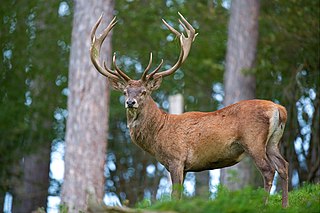 W
WThe red deer is one of the largest deer species. The red deer inhabits most of Europe, the Caucasus Mountains region, Asia Minor, Iran, parts of western Asia, and central Asia. It also inhabits the Atlas Mountains region between Morocco and Tunisia in northwestern Africa, being the only species of deer to inhabit Africa. Red deer have been introduced to other areas, including Australia, New Zealand, the United States, Canada, Peru, Uruguay, Chile, and Argentina. In many parts of the world, the meat (venison) from red deer is used as a food source.
 W
WThe dromedary, also called the Arabian camel, is a large, even-toed ungulate with one hump on its back.
 W
WThe Egyptian pygmy shrew or sacred shrew is a species of mammal in the family Soricidae. It is endemic to Egypt. Its natural habitat is arable land. It is threatened by habitat loss, partially caused by the construction of the Aswan Dam. They are 48–62 mm in length, making them one of the smallest shrews in Egypt. They weigh 7 grams.
 W
WThe Egyptian wolf is a subspecies of African golden wolf native to northern, eastern and a part of western Africa.
 W
WThe North African elephant is an extinct subspecies of the African bush elephant, or possibly a separate elephant species, that existed in North Africa, north of the Sahara, until it died out in Roman times. These were the famous war elephants used by Carthage in the Punic Wars, their conflict with the Roman Republic. Although the subspecies has been formally described, it has not been widely recognized by taxonomists. Other names for this animal include the North African forest elephant, Carthaginian elephant, and Atlas elephant. Originally, its natural range probably extended across North Africa and down to the present Sudanese and Eritrean coasts.
 W
WThe European rabbit or coney is a species of rabbit native to southwestern Europe and to northwest Africa. It has been widely introduced elsewhere, often with devastating effects on local biodiversity. However, its decline in its native range, has caused the decline of its highly dependent predators, the Iberian lynx and the Spanish imperial eagle. It is known as an invasive species because it has been introduced to countries on all continents with the exception of Antarctica, and has caused many problems within the environment and ecosystems. Feral European rabbits in Australia have had a devastating impact, due in part to the lack of natural predators there.
 W
WThe fallow deer is a species of ruminant mammal belonging to the family Cervidae. It is native to Europe, but has been introduced around the world.
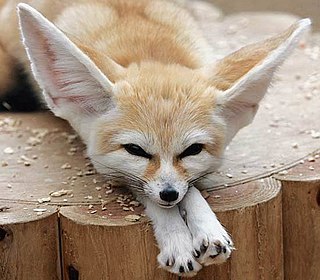 W
WThe fennec fox is a small crepuscular fox native to the Sahara Desert and the Sinai Peninsula. Its most distinctive feature is its unusually large ears, which serve to dissipate heat. The fennec is the smallest canid species. Its coat, ears, and kidney functions have adapted to the desert environment with high temperatures and little water. Also, its hearing is sensitive to hear prey moving underground. It mainly eats insects, small mammals, and birds. The fennec has a life span of up to 14 years in captivity and about 10 years in the wild. Its main predators are the Verreaux's eagle-owl, jackals, and other large mammals. Fennec families dig out burrows in the sand for habitation and protection, which can be as large as 120 m2 (1,292 sq ft) and adjoin the burrows of other families. Precise population figures are not known but are estimated from the frequency of sightings; these indicate that the fennec is currently not threatened by extinction. Knowledge of social interactions is limited to information gathered from captive animals. The fennec is usually assigned to the genus Vulpes; however, this is debated due to differences between the fennec and other fox species. The fennec's fur is prized by the indigenous peoples of North Africa, and in some parts of the world, it is considered an exotic pet.
 W
WRüppell's fox, also called Rüppell’s sand fox, is a fox species living in desert and semi-desert regions of North Africa, the Middle East, and southwestern Asia. It has been listed as Least Concern on the IUCN Red List since 2008. It is named after the German naturalist Eduard Rüppell.
 W
WThe rhim gazelle or rhim, also known as the slender-horned gazelle, African sand gazelle or Loder's gazelle, is a pale-coated gazelle with long slender horns and well adapted to desert life. It is considered an endangered species because fewer than 2500 are left in the wild. These gazelles are found in Algeria, Chad, Egypt, Libya and Sudan.
 W
WThe greater white-toothed shrew is a small insectivorous mammal found in Europe and North Africa. It is the most common of the white-toothed shrews. This species is found along the Mediterranean, Netherlands, Belgium, Ireland, Germany and Portugal; in addition, the Osorio shrew of the Canary island of Gran Canaria, originally described as a separate species, was later discovered to be a population of introduced greater white-toothed shrew. Furthermore, a subspecies of the greater white-toothed shrew, Crocidura russula ibicensis, is found on the Mediterranean island of Ibiza. In April 2008, the greater white-toothed shrew was discovered in Ireland as well. Its preferred habitats are grassland and woodland. It is slightly larger than the lesser white-toothed shrew but otherwise very similar and can often be distinguished only by close inspection of its teeth which are unpigmented.
 W
WThe Cape hare, also called the desert hare, is a hare native to Africa and Arabia extending into India.
 W
WThe bubal hartebeest, also known as northern hartebeest or bubal antelope or simply bubal is the extinct nominal subspecies of hartebeest. It was formerly found north of the Saharan Desert. Other subspecies live currently in grasslands south of the Sahara, from Senegal in the west to Eritrea and Ethiopia in the east and down to central Tanzania. The red hartebeest and Lichtenstein's hartebeest, alternatively considered subspecies or sister species of the common hartebeest, are present in southern Africa.
 W
WThe desert hedgehog is a species of mammal in the family Erinaceidae.
 W
WThe North African hedgehog or Algerian hedgehog, is a mammal species in the family Erinaceidae native to Algeria, Libya, Malta, Morocco, Spain, and Tunisia. Little is known about this hedgehog, even though the most common breed of domesticated hedgehogs is a result of crossing a four-toed hedgehog with a North African hedgehog. Because this species of hedgehog is native to Africa, it has been suggested that it was introduced by humans to the other countries where it is now found, including France, Spain and the Canary Islands. Of the four African hedgehog species, the North African hedgehog is the only one of these hedgehogs that occurs outside Africa. Because the North African hedgehog has such a wide habitat range and has a seemingly stable population, both in the wild and in the domesticated capacity, it does not appear to currently be at risk.
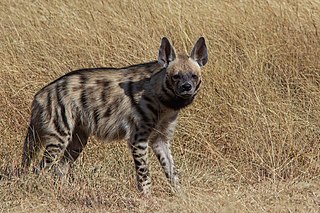 W
WThe striped hyena is a species of hyena native to North and East Africa, the Middle East, the Caucasus, Central Asia and the Indian subcontinent. It is listed by the IUCN as near-threatened, as the global population is estimated to be under 10,000 mature individuals which continues to experience deliberate and incidental persecution along with a decrease in its prey base such that it may come close to meeting a continuing decline of 10% over the next three generations. It is also the national animal of Lebanon.
 W
WKuhl's pipistrelle is a species of vesper bat that lives over large areas of North Africa, southern Europe and Western Asia. It can be found in temperate forests, subtropical or tropical dry shrubland, Mediterranean-type shrubby vegetation, temperate grassland, rural gardens, and urban areas.
 W
WThe lesser mouse-tailed bat is a species of microbat in the family Rhinopomatidae. Also referred to as Hardwicke's lesser mouse-tailed bat and long-tailed bat, it is named after Major General Thomas Hardwicke (1755–1835), an English soldier and naturalist who served many years in India. It is found in North Africa, some parts of central and eastern Africa, West Asia and east to the Indian subcontinent.
 W
WThe lesser noctule, Leisler's bat or the Irish bat, is a species of insectivorous bat belonging to the vesper bat family, Vespertilionidae. The species was named to honour the naturalist Johann Philipp Achilles Leisler
 W
WThe lesser white-toothed shrew is a tiny shrew with a widespread distribution in Africa, Asia and Europe. Its preferred habitat is scrub and gardens and it feeds on insects, arachnids, worms, gastropods, newts and small rodents, though its diet usually varies according to the biotope where it lives. The closely related Asian lesser white-toothed shrew was once included in this species, but is now considered to be a separate species.
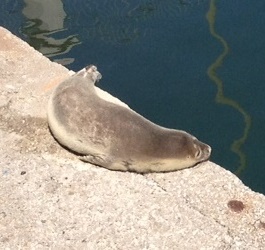 W
WThe Mediterranean monk seal is a monk seal belonging to the family Phocidae. As of 2015, it is estimated that fewer than 700 individuals survive in three or four isolated subpopulations in the Mediterranean, (especially) in the Aegean Sea, the archipelago of Madeira and the Cabo Blanco area in the northeastern Atlantic Ocean. It is believed to be the world's rarest pinniped species.
 W
WThe North African elephant shrew or North African sengi is a species of elephant shrew in the family Macroscelididae. It is found in Algeria, Libya, Morocco, and Tunisia, and is the only extant afrotherian within its range. The species was formerly classified in the genus Elephantulus, but molecular evidence indicates that it is more closely related to Petrodromus than to other members of Elephantulus. It was moved to a new genus, Petrosaltator, in 2016. The split with Petrodromus likely occurred during the Miocene period.
 W
WThe northern giraffe, also known as three-horned giraffe, is the type species of giraffe native to North Africa.
 W
WThe Nubian giraffe is the nominate subspecies of giraffe. It is found in Ethiopia, Kenya, Uganda, South Sudan and Sudan. It is currently extinct in the wild of the Democratic Republic of Congo, Egypt and Eritrea. The Nubian giraffe used to be widespread everywhere on Northeast Africa. The subspecies was listed as Critically Endangered by the IUCN in 2018.
 W
WThe Nubian wild ass is the nominate subspecies of African wild ass, and one of the ancestors of the domestic donkey, which was domesticated about 6,000 years ago. It is presumed to be extinct, though two populations potentially survive on the Caribbean island of Bonaire and in Gebel Elba.
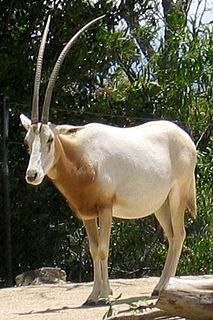 W
WThe scimitar oryx, also known as the scimitar-horned oryx and the Sahara oryx, is a species of Oryx that was once widespread across North Africa. The species went extinct in the wild in 2000, but a group was released into an acclimation enclosure within the Ouadi Rimé-Ouadi Achim Faunal Reserve in 2016, then reintroduced back into the wild. Twenty-one additional animals were placed in the acclimation enclosure in 2017.
 W
WThe Saharan striped polecat, also known as the Saharan striped weasel, Libyan striped weasel, and the North African striped weasel is a species of mammal in the family Mustelidae. This animal is sometimes characterized as being a part of the genus Poecilictis, and its coloration resembles that of the striped polecat.
 W
WThe serval is a wild cat native to Africa. It is rare in North Africa and the Sahel, but widespread in sub-Saharan countries except rainforest regions. On the IUCN Red List it is listed as Least Concern. Across its range, it occurs in protected areas, and hunting it is either prohibited or regulated in range countries.
 W
WThe Cyrenaica shrew or Alexander's shrew is a species of white-toothed shrew in the family Soricidae which is endemic to Libya.
 W
WThe Saharan shrew is a species of mammal in the family Soricidae. It is found in Mauritania and Morocco. Its natural habitats are rocky areas and sandy shores. It is threatened by habitat loss.
 W
WWhitaker's shrew is a species of mammal in the family Soricidae. It is found in Western Sahara, Algeria, Morocco, Tunisia. Its natural habitats are subtropical or tropical dry shrubland, rocky and sandy coasts. It is a fairly common species and the International Union for Conservation of Nature has rated its conservation status as being of "least concern".
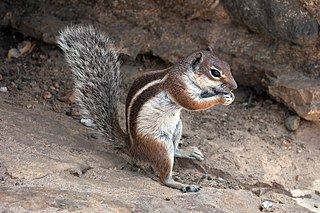 W
WThe Barbary ground squirrel is a species of rodent in the family Sciuridae. It is monotypic within the genus Atlantoxerus. It is endemic to Western Sahara, Algeria and Morocco and has been introduced into the Canary Islands. Its natural habitats are subtropical or tropical dry shrubland, temperate grassland and rocky areas where it lives colonially in burrows. It was first described by Carl Linnaeus in his landmark 1758 10th edition of Systema Naturae.
 W
WThe western barbastelle, also known as the barbastelle or barbastelle bat, is a European bat in the genus Barbastella. This species is found from Portugal to Azerbaijan and from Sweden to Canary Islands, where a sub-species was identified. It has a short nose, small eyes and wide ears. The conservation status of B. barbastellus is assessed as "Near Threatened", "Vulnerable", "Critically Endangered" or "Extinct" in various parts of its range.